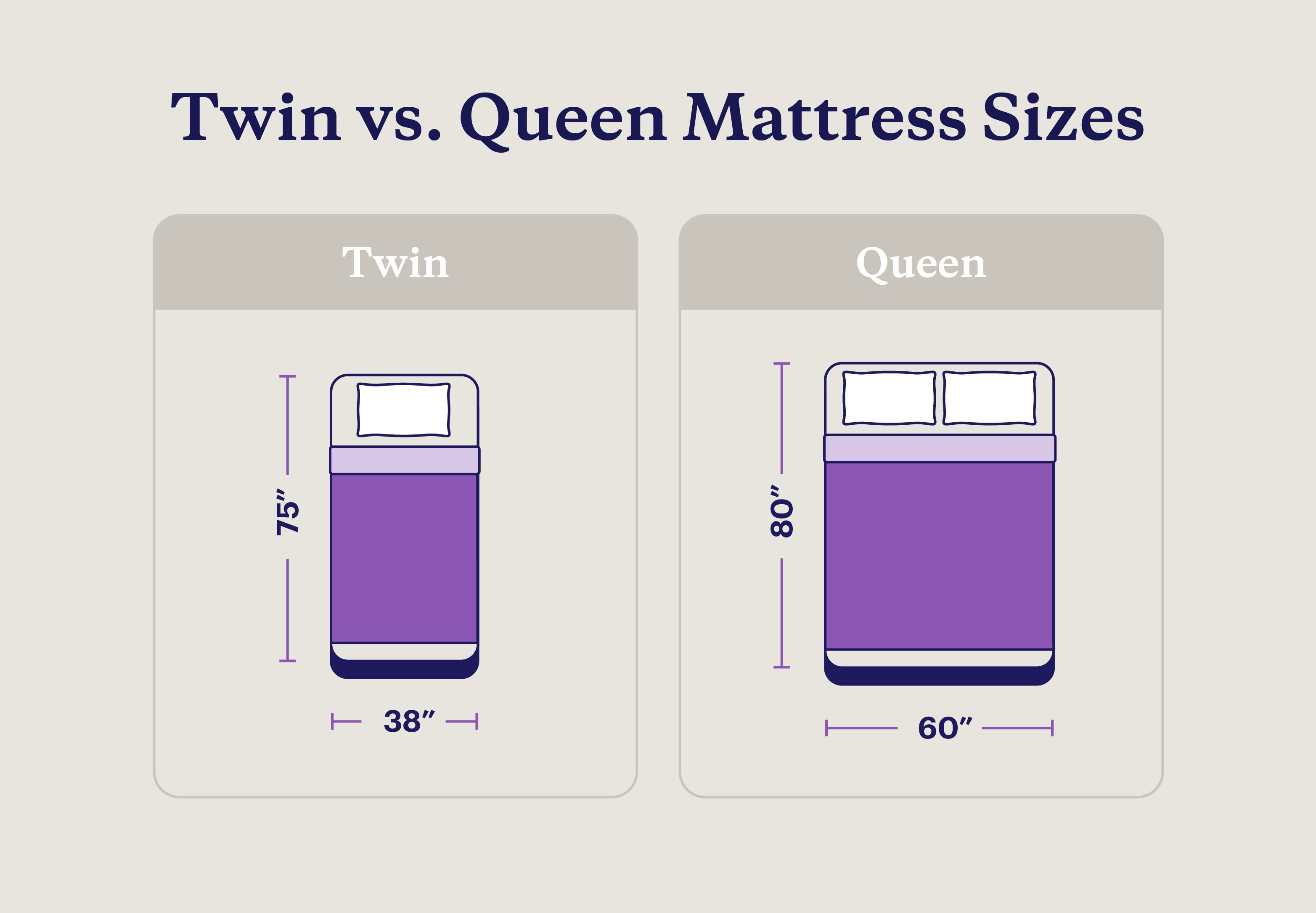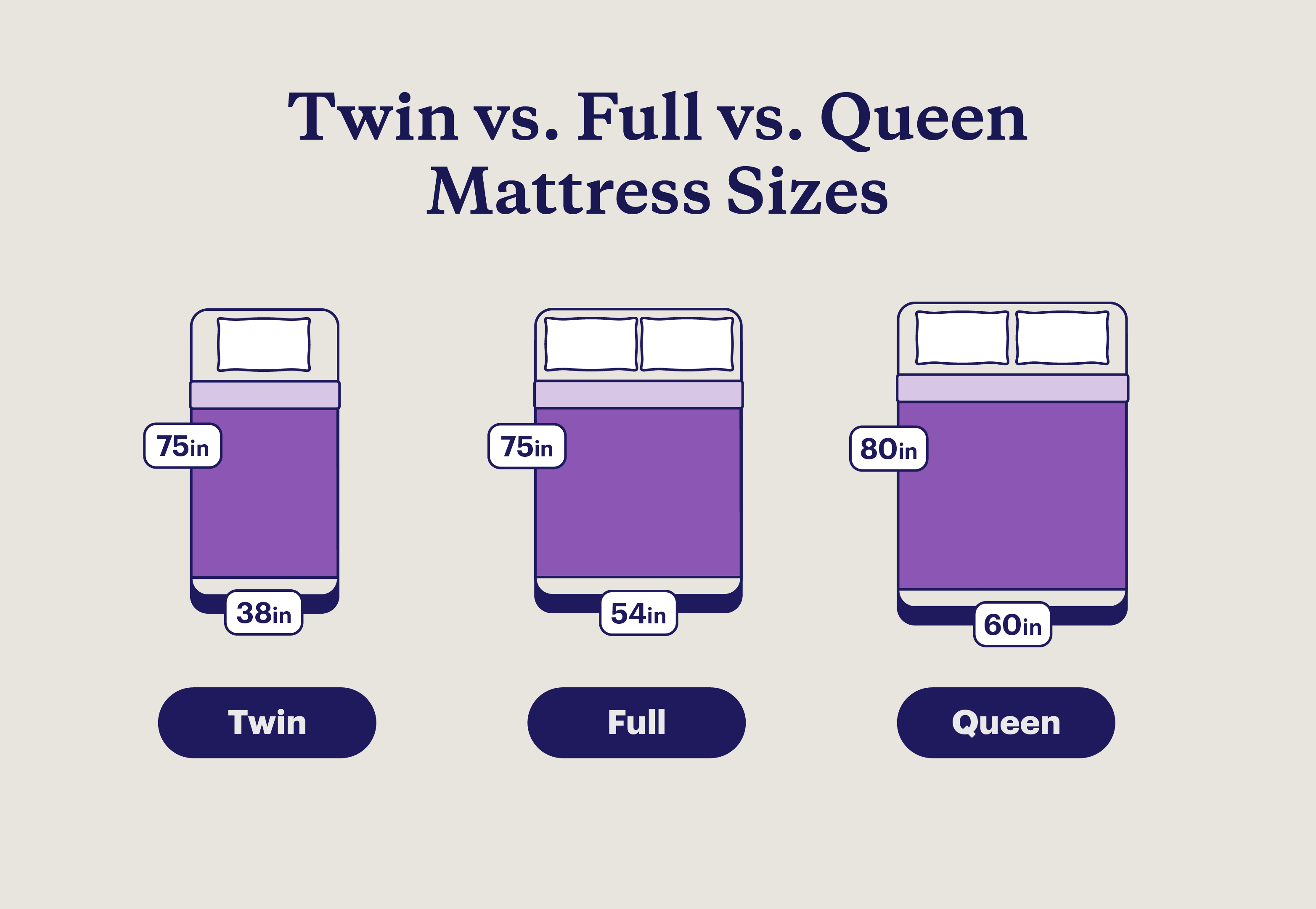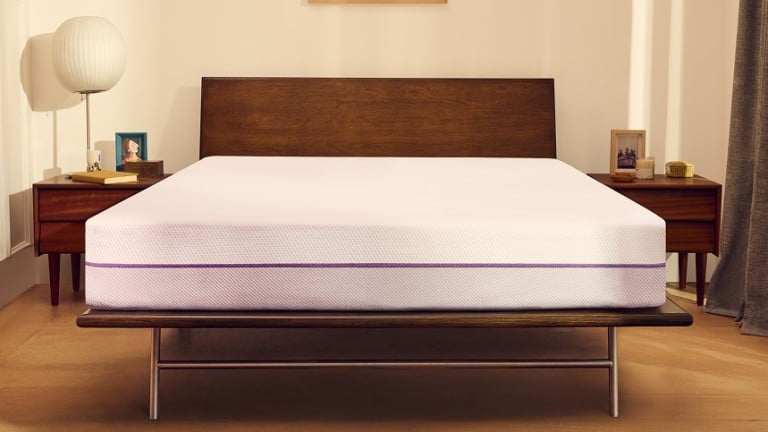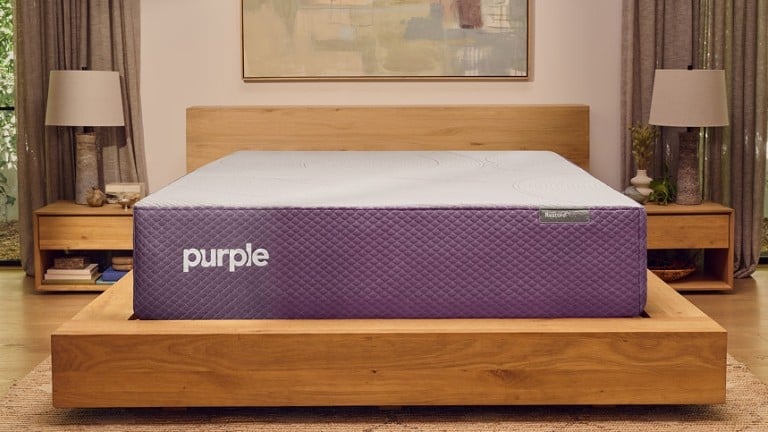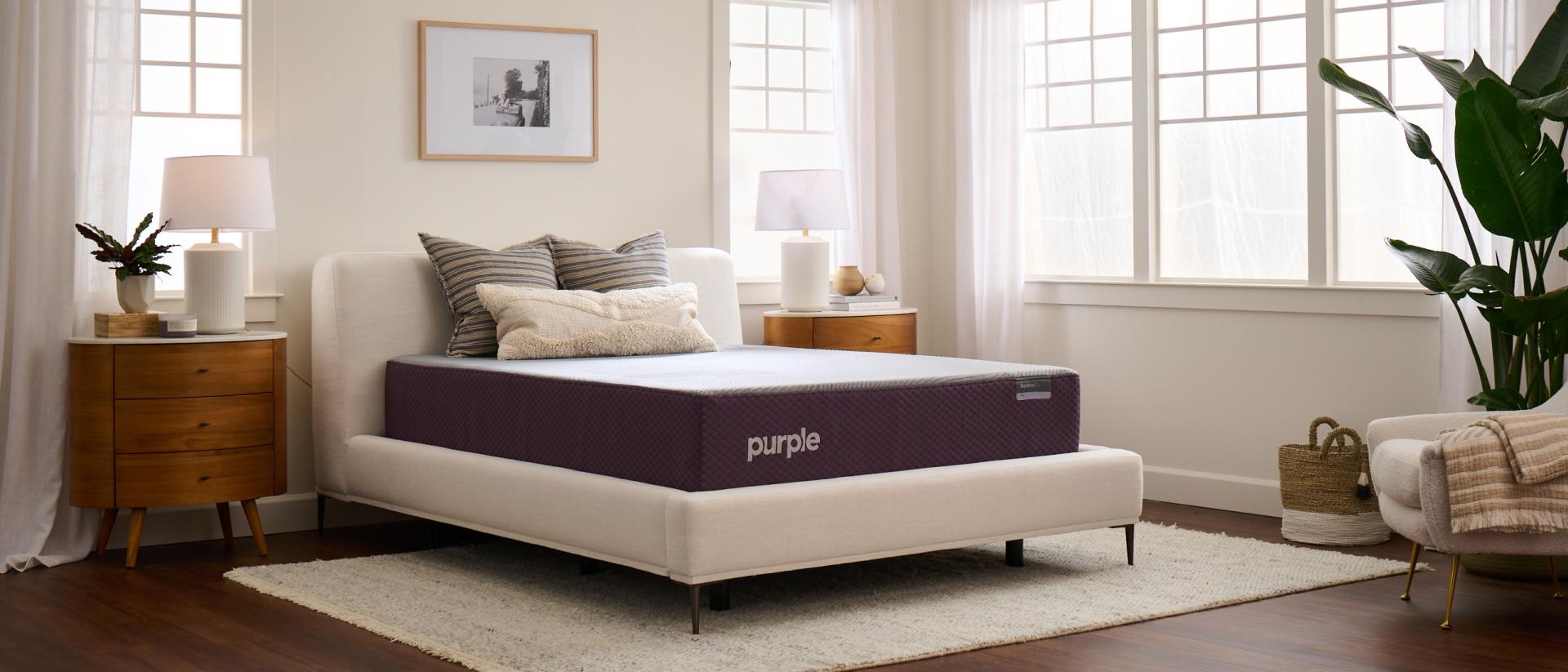
Twin vs. Queen Mattress: Key Differences + Size Guide
Key Takeaways
- Twin mattresses measure 38-by-75 inches and serve as a great option for kids or single sleepers.
- Queen mattresses measure 60-by-80 inches and are well-suited for couples.
- A common misbelief is that two twin mattresses make a queen but this is not true, as the combined width of two twins is 16 inches greater than a queen.
- When looking for an in-between mattress size, many people opt for a full bed. When comparing twin vs. full vs. queen, a full is wider than a twin and smaller than a queen on all sides.
Choosing the perfect mattress can significantly impact the quality of your sleep — and one of the biggest factors to consider when choosing a mattress is size.
Twin and queen mattresses are two of the most common bed sizes available today, but each serve very different purposes. The twin is best for single sleepers, whereas a queen bed can sleep two.
Browse Purple’s mattresses in twin and queen sizes — or full beds if you’re looking for a mid-size option and king beds if you’re in need of something larger. Not sure which size is best for you? Here, we compare the differences, options, and considerations for twin vs. queen mattresses to help you decide.
What Is a Twin Mattress?
Dimensions: 38 inches wide by 75 inches long
A twin mattress is the smallest of the standard mattress sizes. Measuring 38 inches in width and 75 inches in length, twin size mattresses can only fit a small- to average size single sleeper. Its narrow width means that it can fit in small and narrow bedrooms with limited floor space. As such, it's a common option for furnishing teens' bedrooms and college dorms.
Some single adults can also make do with a standard twin or single bed. But bear in mind that this bed size doesn't leave much room for extra pillows or moving around. For reference, a twin bed is a full 22 inches narrower and 5 inches shorter than a queen.
Pros | Cons |
| Saves space and works well in narrow rooms | Not much room to stretch out |
| Perfect for kids and college dorms | Not suitable for larger bodies |
| Lowest-priced mattress size | Not suitable for more than one person |
Pros of Twin Beds
- Twin beds save space. Twin size mattresses are perfect for teens and young adults living in dorms. They take up very little floor space compared to other bed sizes. The minimum room size for a twin bed is just 7-by-10 feet.
Twin beds are relatively inexpensive. Since they take fewer materials to make, twin beds are often less expensive than larger sizes. As such, they're great for people who are on a tight budget.
Cons of Twin Beds
- Twin beds don’t leave you much room to stretch out. With limited space to move around, you might not be able to sleep well at night or do much else in bed.
- Twin beds aren’t suitable for someone with a bigger body size. People on the heavier side and tall sleepers may feel cramped in a twin bed. Twin beds are just over 6 feet long, which means that any sleeper over 6 feet will have trouble fitting comfortably.
What Is a Queen Mattress?
Dimensions: 60 inches wide by 80 inches long
A queen mattress measures 60 inches wide and 80 inches long. As they are large enough to accommodate two adults while still providing some extra space to stretch out, queen size mattresses are the most popular choice for couples in the U.S.1
Aside from providing two sleepers with enough personal sleeping space, queen mattresses can oftentimes fit two adults and a small pet or child. This makes the mattress an ideal choice for young couples and small families.
The minimum bedroom size for a queen size bed is 10-by-10 feet. In contrast, king beds require at least 12-by-12 feet of space. As such, queen beds are often the preferred choice in guest bedrooms and non-primary bedrooms.
Pros | Cons |
| Most common size for couples | May feel too bulky in small rooms |
| Plenty of space for a single sleeper | May not be enough room for couples with larger bodies |
| Fits well in a standard size bedroom | May be too narrow for restless couples |
| Most affordable large mattress size | May be too short for individuals over 6 feet |
| Widely available | Usually heavier than a twin mattress |
Pros of Queen Beds
- Queen beds are one of the best bed sizes for couples. It's big enough to fit two people comfortably without occupying too much floor space that could otherwise go to furniture.
- Queen beds work as a great centerpiece in a primary bedroom. Whether your bedroom is big or average, a queen size bed can stand as the main focal point of your bedroom. Smaller beds might look awkward in big rooms (especially with sparse furniture), and bigger beds might make small rooms appear even smaller than they already are.
Queen beds are widely available. As one of the most popular bed sizes out there, queen size mattresses are commonly available in a wide selection of mattress types. You'll be hard-pressed to find a mattress manufacturer that doesn't produce queen size beds.
Cons of Queen Beds
- Queen beds may feel too bulky in small rooms. If you're planning on getting a mattress for a non-primary bedroom, first confirm that it can accommodate a queen size bed. Queen beds work best in bedrooms that are at least 10-by-10 feet in size.
- Queen beds may not be enough room for some couples. Queen size beds are just big enough to accommodate two adult sleepers. But if you need extra sleeping space for a big dog or kids ages 3 and up, you'll probably have to upgrade to a bigger bed.
Difference Between Twin and Queen Size Mattresses
The main difference between twin and queen mattresses is their size. Queen mattresses measure 60-by-80 inches while twin mattresses measure 38-by-75 inches.
The biggest benefit of choosing a queen size bed over a twin is more space. Queen beds are 22 inches wider and 5 inches longer than a twin bed. A queen is simply more spacious for single sleepers and couples.
Whether you prefer to sleep alone or with a partner, a queen mattress lets you stretch out in bed and have your personal sleeping space. This makes the queen bed an excellent option for restless sleepers who toss and turn at night, run hot in their sleep, or don't enjoy being too close to their partner during the night.
On the flip side, queen size beds take up more floor space than twin or twin XL size beds. If you're a single sleeper with little room to spare, you're probably better off with a twin or full bed.
Twin | Queen | |
Mattress Dimensions (in) | 38 x 75 | 60 x 80 |
Mattress Dimensions (cm) | 96.5 x 190.5 | 152.4 x 203.2 |
Recommended Room Size | 7’ x 10’ | 10’ x 10’ |
Comfortably Fits | Single sleepers, typically children or teens | Single sleepers, couples, or those who co-sleep with their small kids and/or pets |
Commonly Used In | Kids’ rooms, bunk rooms, small bedrooms, college dorm rooms, studio apartments, guest bedrooms | Primary bedrooms and guest bedrooms |
Price | $ | $$$ |
Variations in Twin and Queen Size Mattresses
Standard twin and queen mattresses are two of many options available. Here are some variations within these size categories you can consider.
Twin XL Mattress
Dimensions: 38 inches wide by 80 inches long
The twin XL mattress measures 38-by-80 inches. Twin XLs are the same width as standard twins but are 5 inches longer. Compared to twin mattresses, twin XL mattresses are designed to fit taller teens and tall adults who don't mind sleeping in a narrow bed.
Short Queen Mattress
Dimensions: 60 inches wide by 75 inches long
Short queen mattresses measure 60-by-75 inches. They're just 5 inches shorter than standard queens — the same length as a twin — and are the preferred choice of mattress size for RVs and campers. As such, it's often called an RV queen mattress.
Split Queen Mattress
Dimensions: 60 inches wide by 80 inches long
A split queen has the same dimensions as a standard queen — 60-by-80 inches — but with a separation in the center that creates two sides of the bed. Split queens are not very common making them hard to find.
Some mattress retailers offer adjustable split top mattresses in queen sizes that only separate at the head of the bed. This allows individuals to sleep at different inclines.
Other split queen manufacturers make two entirely separate mattresses made to fit a queen bed frame. Unlike the twin XL which can be combined to make a split king, a split queen’s individual mattresses are not sold individually, as they are very narrow at 30 inches wide. For reference, crib mattresses are about 27 inches wide.
California Queen Mattress
Dimensions: 60 inches wide by 84 inches long
California queen mattresses measure 60-by-84 inches. The California queen is the same width as a standard queen but 4 inches longer — equalling the length of a California king, hence their matching names. Unlike the California king, though, the California queen is not widely available.
Olympic Queen Mattress
Dimensions: 66 inches wide by 80 inches long
Olympic queen mattresses measure 66-by-80 inches. This type of mattress is 6 inches wider than the standard queen and can accommodate two adults and a small child or pet with some wiggle room to spare.
The biggest drawback to this size is that it isn't as readily available as most standard sizes.
Twin vs. Full vs. Queen: The Middle-Ground Option
A full bed measures 54 inches wide and 75 inches long — totaling 4,050 square inches of sleeping space. When comparing twin vs. full vs. queen mattresses, a full falls between a twin and queen but comes closest to the queen’s dimensions. Compared to a twin, a full is 16 inches wider but the same length. In comparison to a queen, a full is 6 inches narrower and 5 inches shorter.
If neither a twin or queen sounds like the right fit for you, consider a full bed instead. Most single adult sleepers find a twin too small for nightly use, especially in an average or large size bedroom. But if the bedroom isn’t quite big enough to comfortably accommodate a queen, then a full is the best option.
Full beds are widely available but not all mattress manufacturers make them. From twin to split king, Purple mattresses are available in a range of standard bed sizes. Some of our hybrid and luxury mattresses are not sold in twin or full sizes but all Purple mattresses are sold in queen and king sizes. See the table below to see which of our mattresses are sold in twin, full, and queen sizes.
Collection | Twin | Full | Queen |
| ☑ | ☑ | ☑ | |
| ☐ | ☑ (except RestorePlus™ hybrid) | ☑ | |
| ☐ | ☐ | ☑ |
Factors To Consider When Deciding Between a Twin vs. Queen
When choosing a mattress and comparing twin vs. queen size mattresses, make sure to first consider the following factors to help you decide which size is best for you.
Number of Sleepers
The number of people sleeping in a bed is the most important aspect that influences what size bed you should get. Naturally, the more occupants, the bigger your bed should be. For twin and queen beds, you can expect to fit:
- Twin: One sleeper
- Queen: Two sleepers
When it comes to widely available mattress sizes, twin, twin XL, and full beds are best for single sleepers, while queen, king, super king, and California king beds are best for couples and families.
Room Size and Layout
Your bedroom is the second most important consideration when comparing bed sizes. Its dimensions, shape, layout, and everything inside all factor into what size bed your room can fit.
How big is your bedroom? Is it square-shaped or rectangular? What is the placement of the doors, windows, and closet space? Can you arrange your bedroom furniture to accommodate a larger bed?
Below are the recommended room sizes for twin and queen beds:
- Twin: 7-by-10 feet
- Queen: 10-by-10 feet
Sleeping Preferences
Your sleep behaviors, style, and preferences also play into what size bed you may find most comfortable. Consider your sleep position — are you a stomach sleeper, a side sleeper, or a back sleeper? Do you prefer to sleep in the fetal position or do you like being splayed out like a starfish? If you switch positions frequently or sprawl out, you may find a twin too small.
Do you sleep like a log or do you wake up at the slightest sound or movement? For couples where one or both partners toss and turn, sleep hot, or wake up easily, we recommend opting for a bigger bed. For some couples, this may even mean graduating to a king bed.
Bed Frame Material and Design
Most bed frames are 2-5 inches bigger than their corresponding mattress. But additional features found in many bed frames, like headboards, footboards, and pull-out drawers, can significantly impact how much space you'll have left for all your other furniture.
Below are the average twin and queen bed frame dimensions.
- Twin bed frame dimensions: 40-43 inches by 77-80 inches
- Queen bed frame dimensions: 62-65 inches by 82-85 inches
Which Bed Size Is the Best for You?
When comparing twin vs. queen mattresses, you should remember that the best bed size is the one that complements your lifestyle, sleep preferences, room size and layout, and the number of sleepers.
Using a twin bed can save you a lot of space, but it can only fit one sleeper. Queen size mattresses cost more and can accommodate couples and a small pet or children. But remember, the size difference between twin, full, and queen mattresses are not extraordinary. So if a twin is too small but a queen is too large for your needs, you can also opt for a full instead.
Bear in mind that bed size is not the only thing to consider when shopping for a new mattress. The material, firmness, and thickness of a mattress all play a part in its overall comfort, supportiveness, and suitability.
At Purple, we offer a wide range of mattresses in standard sizes and firmnesses, from plush to firm, to suit a variety of needs. Find a Purple retailer near you or shop online for a mattress today.
FAQ
No, two twins do not make a queen, as a queen size bed is not as wide as two twin beds. Side-by-side, two twin beds are bigger than a queen, measuring 76 inches wide, while a queen measures 60 inches wide. Two twin XL beds together make a split king size bed.
No, a twin bed is 75 inches long. This makes a twin 5 inches shorter than a queen, which measures 80 inches in length.
A queen bed is bigger than a single twin by 22 inches in width and 5 inches in length — a total of nearly 2,000 square inches of sleeping space.
No, twin beds are not too small for adults. At just over 6 feet in length, twin mattresses can accommodate most average size adults. Still, twin beds are often marketed toward teens and young adults.
No, most wouldn’t find it comfortable for two adults to sleep on a twin bed, even for the cuddliest of couples. At 38 inches, a twin is wide enough for a single adult sleeper.
No, twin mattresses are not the same as double mattresses. Twin beds measure 38-by-75 inches while double (also known as full) beds measure 54-by-75 inches.
More To Explore
Level up your sleep routine with our most-loved products.

